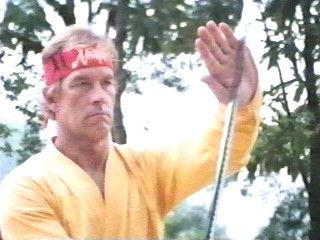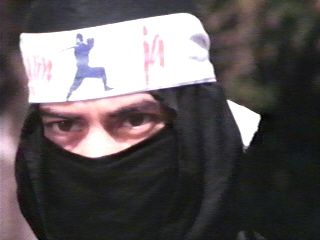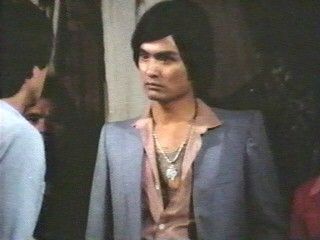
|
|
|
|
|
|
|
|
|
|
|
|
|
(1988) Director: Joseph
Lai
Another review of one of those Joseph Lai ninja cut-and-paste jobs? Well, why not? It's been a while since I've taken a look at one of these movies, and even the weaker efforts of these quickies are guaranteed to at least have a few good unintended laughs. Plus, since I now have the ability to take still pictures from the movies I review and put them on display, I thought it would be a good opportunity to give a visual sample of them to those readers unlucky to not have any available to rent in their city. This particular ninja movie - Ninja Strike Force - was one of the last of its kind to be release. By the time of its release, the ninja craze in the United States was pretty much over, save for one or two more entries in the American Ninja series to follow. The demand for ninjas in the U.S. had all but dried up for Lai and his cronies in just a few years, in part due to people finding it hard to any longer picture the ninja as a deadly and ruthless assassin - and that ironically came from the movies Lai was making. The cut-and-pasting of footage from non-ninja movies with several minutes of newly filmed ninja footage transformed the ninja into something seen as cheap and weak. It certainly didn't help that in that the new ninja footage, the ninjas were often made to do some seriously goofy activities, making them look pretty feeble-minded instead of cunning and deadly. Still, the diminishing returns didn't seem to have
pushed Lai into improving their ninja movies, which is evident right
from the start of
The story opens with two ninjas dressed in yellow (great disguise!) walking through the forest. Gordon the ninja (Harrison, who is usually named "Gordon" in these ninja films) asks his Caucasian ninja master (who looks ten years younger than Harrison) about the rusty sword he is carrying, and why he performs a ritual with it at every full moon. Master explains that the sword originates from the evil black ninja clan, and years before his own master stole it from them. Gordon's master explains that the sword has a "great power", and it can "dominate the evil spirit that uses it." Also, should all the ninja masters of the five big ninja clans get killed, the sword will become invincible. "Invincible"? Does that mean it becomes as tough as those knives on TV that can cut through a pipe then immediately slice through a tomato like a hot knife through butter? Anyway, what you've guessed happens next does indeed happen - Gordon's master is soon attacked by a black ninja, who manages to use a blowgun to blow a cloud of deadly red dust in the face of Gordon's master from a distance at least ten feet away, and the sword is stolen. Gordon goes to his dying master and offers to get the sword, but he is told that he's not strong enough. Instead, he should warn the other four clans, and get in contact with the son of the master of Gordon's master (I hope that makes sense.) Gordon's master hands him a photo of the man to get in contact with, a blurry snapshot with the man in a goofy open-mouthed expression. Obviously, this photo was derived not from an ordinary picture-taking, but was instead an image taken from the original movie that this movie subsequently starts stealing footage from. It's here that the original movie starts. We meet
"Jim", the reported lone descendent of the great master who stole the
black ninja's sword. Though it seems A red ninja is then seen working out. The black ninja suddenly appears with the sword and says "Prepare to die!" The red ninja gasps at seeing the black ninja with "the sword of catastrophe". The subsequent fight actually is pretty well choreographed, but Lai must have known he was onto something genuinely good, because the fight abruptly ends after a few seconds, the black ninja victorious. Jim then becomes a waiter, but he soon finds himself in conflict with management again, when he sees a poor waitress confronted by a rude customer who SHOUTS EVERY WORD, though mysteriously the customers next to his table seem mighty slow to notice his loud and obnoxious behavior. Jim steps in and gets into hot water when he makes a suggestion to the customer: "Maybe you'd like a massage", which for some reason doesn't endear himself to the customer or the manager. So once again Jim pulls off the "You can't fire me, I quit" routine and leaves the restaurant. While he's at home (if you can call the place a "home") painting signs with that little kid, a fellow named Mickey runs in and hides, running from a crime lord who discovered that he was cheating at cards. When the crime lord and his cronies arrive, Jim doesn't reveal where Mickey is, which leads him to be beaten and that little kid getting wrapped mummy-style neck to toe with a long rubber hose, which, judging from his expressions, the kid thinks is as ridiculous as the audience. Mickey comes out from hiding when the bad guys leaves, confused as to why Jim didn't reveal where he was. Some better questions to ask would be: Just who is that kid? Does Mickey have some relationship with Jim that we don't know about? The biggest question, however, is just when is Jim going to get involved with this ninja crisis? It's about here that the amiable feeling the movie has
generated (unintentionally) starts to slip away. True, the movie does
from this point I must admit, however, that even in a movie with such a
sombre story, it still managed to come up with a number of really
unintentionally funny moments. Though the behavior of Jim, Mickey, and
the boy may be totally innocent in Asian eyes, it becomes weirdly
homoerotic in a western viewpoint, with tender music playing as Mickey
caresses the cheek of the beaten-up Jim, or the young boy frantically
grabbing the ass of one of the men when he wants attention. The disco
era was still alive in Taiwan (where this was apparently shot) at the
time of filming, and we get to see a good number of cheesy outfits, as
well as people in class having epileptic fits while telling their
fellow students they should get down and boogie that night. The more
serious sequences are scored with strange choices of music, ripping off
the theme from The Elephant Man as well an
instrumental rendition of Send In The Clowns. Speaking of
people in goofy outfits, the idea of ninjas cartwheeling around near
Jon Voight and Dustin Hoffman (or, to be more precise, amateurs
imitating the characters those two actors This is how almost every newly-shot insert subsequently shown goes: Start off with the sight of a brightly-colored ninja working out. Then the black ninja appears. The two ninjas bash their weapons together for about ten seconds until the black ninja makes a fatal blow. The downed ninja, lying on the ground, struggles to raise his head, then suddenly collapses dead. Then the black ninja takes off the part of his mask covering his face, and makes a sneery expression. The countless re-enactments of this scene actually makes up about 90% of the ninja footage here. Not only is this ninja footage unimaginative, there's barely any connection attempted to tie this with the story of Jim and what's happening to him. The only way Jim ends up helping Gordon comes in a scene when Gordon gets a package from Jim, containing instructions on how to defeat the black ninja. Needless to say, Jim isn't even in this scene. Oh, there are a couple of instances when Lai tries to edit footage of Gordon into redubbed footage of Jim so that it looks like they are in the same room having a conversation, but this sneaky technique is even more evident than when it was used in Ninja Champion. There's a desperate feel to this movie instead of the joyful "who cares about logic" attitude found in the earlier ninja movies, even in the ones that weren't quite successful in delivering ample hilarity. While this late entry shows that there was still some humor to be found with ninjitsu, the lax attitude suggests that maybe they were wise to stop their efforts around this point. Check for availability on Amazon (VHS) See also: Ninja Champion, Ninja: Silent Assassin, Robo Vampire |
 Ninja Strike Force.
Despite being in his 50s and really showing his age, once again veteran
ninja star Richard Harrison is the action star here. In the opening
credits he and a Chinese fellow use their swords to perform various
ninja poses, some of which are quite embarrassing, like a lengthy shot
with a frozen Harrison pushing his sword against the sword of the
frozen and defending Chinese man - and the Chinese man is on his knees,
staring right into Harrison's groin. The other interesting thing about
the opening credits is that admittedly there seems to have been some
realization by Lai and co. that showing the aging Harrison shirtless
and struggling through martial arts poses might be difficult to pull
off. How else to explain that almost every shot of Harrison in this
opening credits sequence is shot with the sun shining directly behind
him, so he looks more like a silhouette, or in his properly lit
close-ups, a page of lengthy written credits happens to immediately pop
up and cover his wrinkled face?
Ninja Strike Force.
Despite being in his 50s and really showing his age, once again veteran
ninja star Richard Harrison is the action star here. In the opening
credits he and a Chinese fellow use their swords to perform various
ninja poses, some of which are quite embarrassing, like a lengthy shot
with a frozen Harrison pushing his sword against the sword of the
frozen and defending Chinese man - and the Chinese man is on his knees,
staring right into Harrison's groin. The other interesting thing about
the opening credits is that admittedly there seems to have been some
realization by Lai and co. that showing the aging Harrison shirtless
and struggling through martial arts poses might be difficult to pull
off. How else to explain that almost every shot of Harrison in this
opening credits sequence is shot with the sun shining directly behind
him, so he looks more like a silhouette, or in his properly lit
close-ups, a page of lengthy written credits happens to immediately pop
up and cover his wrinkled face? that times are tough
right now, and that nepotism and possible knowledge of martial arts
don't get you far in finding a decent job, because Jim The Great works
as a paperboy and moonlights as a bellboy. He's called into the office
of the hotel manager, and is accused of stealing a cheap-looking
lighter from some customer, since the lighter was found in his
clothing. Some questions come from this: Why would anyone go to the
fuss of reporting the theft of a cheap lighter? Why did management look
in Jim's clothes? Did they even have the right to search through his
clothes? Anyway, Jim proclaims his innocence and does the old "You
can't fire me, I quit" routine, and the next thing we see him do is
move into a crappy abandoned house with some small kid. Who is this
kid? If it's his brother or son, it raises doubt to his "lone
descendent" status.
that times are tough
right now, and that nepotism and possible knowledge of martial arts
don't get you far in finding a decent job, because Jim The Great works
as a paperboy and moonlights as a bellboy. He's called into the office
of the hotel manager, and is accused of stealing a cheap-looking
lighter from some customer, since the lighter was found in his
clothing. Some questions come from this: Why would anyone go to the
fuss of reporting the theft of a cheap lighter? Why did management look
in Jim's clothes? Did they even have the right to search through his
clothes? Anyway, Jim proclaims his innocence and does the old "You
can't fire me, I quit" routine, and the next thing we see him do is
move into a crappy abandoned house with some small kid. Who is this
kid? If it's his brother or son, it raises doubt to his "lone
descendent" status. on start
to answer a lot of the puzzling questions that have built up from this
point - the kid is a street urchin Jim saved, Mickey and Jim had never
met before, the pacifist Jim has a line dubbed in where he says left
his ninja father when he was 14 - but the developing story found in
this non-ninja footage itself runs out of ways to constantly leave us
in stitches. You have to wonder why Lai chose this movie to transform
into a ninja adventure, because the heart of its story is more or less
an Asian take on Midnight Cowboy(!), focusing on the day
to day struggles of Jim (playing the Joe Buck character) and the seedy
Mickey (clearly imitating Ratso Rizzo, right down to getting
tuberculosis), making their home in an abandoned building, trying to
scrape together a living while The Man keeps them down, and Jim having
as much success with women as Joe Buck did. As you can imagine, their
struggles to stay alive under such dire conditions don't exactly lead
them to say or do a lot of unintentionally hilarious things or even add
some gratuitous action of any kind.
on start
to answer a lot of the puzzling questions that have built up from this
point - the kid is a street urchin Jim saved, Mickey and Jim had never
met before, the pacifist Jim has a line dubbed in where he says left
his ninja father when he was 14 - but the developing story found in
this non-ninja footage itself runs out of ways to constantly leave us
in stitches. You have to wonder why Lai chose this movie to transform
into a ninja adventure, because the heart of its story is more or less
an Asian take on Midnight Cowboy(!), focusing on the day
to day struggles of Jim (playing the Joe Buck character) and the seedy
Mickey (clearly imitating Ratso Rizzo, right down to getting
tuberculosis), making their home in an abandoned building, trying to
scrape together a living while The Man keeps them down, and Jim having
as much success with women as Joe Buck did. As you can imagine, their
struggles to stay alive under such dire conditions don't exactly lead
them to say or do a lot of unintentionally hilarious things or even add
some gratuitous action of any kind. played) may initially
sound funny, but the movie soon becomes a bore, especially since the
movie beyond that above point only cuts back to the ninja nonsense for
a few minutes at a time after first spending an exceedingly long period
of time with these two losers. Though the sight of the ninja bashing
their swords together is at first a welcome sight, bringing in some
much-need excitement into the doldrums, it too eventually becomes a
chore to watch. After setting up this situation concerning the black
ninja's plan to knock off the rival ninja leaders one by one, the movie
does nothing to expand on this.
played) may initially
sound funny, but the movie soon becomes a bore, especially since the
movie beyond that above point only cuts back to the ninja nonsense for
a few minutes at a time after first spending an exceedingly long period
of time with these two losers. Though the sight of the ninja bashing
their swords together is at first a welcome sight, bringing in some
much-need excitement into the doldrums, it too eventually becomes a
chore to watch. After setting up this situation concerning the black
ninja's plan to knock off the rival ninja leaders one by one, the movie
does nothing to expand on this.